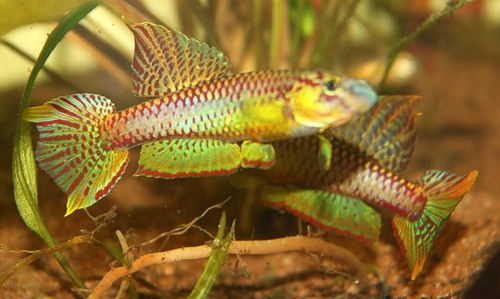

Yoké C 03 / 37
Photo courtesy of Christian Radtke
| Meaning of Name |
From the area they inhabit, Mount Cameroon ( volcanic ). |
|||||||||||||||||||||||||||||||||
| First Description |
Radda A.C. & Wildekamp R.H. 1977. Die Aphyosemion bivittatum superspezies. DKG Journal 9 (9): p 138-141, figures 4 & 6. |
|||||||||||||||||||||||||||||||||
| Size |
5 cm |
|||||||||||||||||||||||||||||||||
| Meristics |
|
|||||||||||||||||||||||||||||||||
| Karyotype |
|
|||||||||||||||||||||||||||||||||
| Sub-Genus |
Chromaphyosemion |
|||||||||||||||||||||||||||||||||
| Group |
|
|||||||||||||||||||||||||||||||||
| Synonyms |
|
|||||||||||||||||||||||||||||||||
Populations
|
ABC 05 / 8 - Mile 11 -
Collected 21st January 2005. Coordonnées N 04 15 14 0 E 09
22 25 1 Altitude 130 m Chutes d'Ekom - Also known as HLM 99 / 1.
GPE 90 / 3 - Distributed in Holland as GPE 90. Mambanda - Possibly also known as Mabanda.
An import from Cameroon December
2022 into the UK.
Meanja -
Mijea -
Mile 4 - JVC 05 - Collected 22/11/2005 - 4km from Limbe to Douala. (Moliwe). Mile 29 - HAH 98 / 303
- Collected 12th June 1998. Muyuka - An import from Cameroon December
2022 into the UK. The bag contained Procatopus,
A.ahli &
E.infrafasciatus.
Other collections at Muyuka from ( poliaki Mile 29 / Sonnenberg 2007 ) -
Penda Mboko -
Yoké -
Wild fish from commercial shipment ex Cameroon.Imported late '90's to England. |
|||||||||||||||||||||||||||||||||
| Type Locality |
The Kaké River, close to the village of Kaké which is near Kumba. The original description gave Kumba as the type locality |
|||||||||||||||||||||||||||||||||
| Distribution |
Mount Cameroon, in the Kaké River system & the northern area of Fernando Poo (currently named Bioko) in the Rio Consul drainage (this island population may or may not belong to A.volcanum). The eastward frontier appears to be the Mungo River. In the west it is Ekondo Titi. Here A.bivittatum takes over. Collecting sites are found on level volcanic rock & sedimentary substrate (Bakundu). |
|||||||||||||||||||||||||||||||||
| Habitat |
Rainforest brooks & streams, mainly on volcanic soils. They prefer swampy areas. |
|||||||||||||||||||||||||||||||||
| Distinguishing Characteristics | Resembles A.splendopleure & can be difficult to seperate in some populations, notably the population from Kumba. A.volcanum is a more robust species showing more colour on the body. | |||||||||||||||||||||||||||||||||
| Colour/Pattern Variability | ||||||||||||||||||||||||||||||||||
| History |
|
|||||||||||||||||||||||||||||||||
| Breeding Notes |
Regarded as a more difficult member of the subgenus. Males can be aggressive & plenty of cover should be provided for the female (s). Parents can be predatory towards young so it's better to take the eggs out frequently & hatch in a seperate container. Water incubation takes 12-14 days. Sexual maturity is attained around 6-7 months. Oliver Legros reports in BKA newsletter No.329,
February 1993 that sex ratio is biased towards males. His Kumba - Kaké
fish were lost due to this. |
|||||||||||||||||||||||||||||||||
| Diameter of Egg | ||||||||||||||||||||||||||||||||||
| Remarks |
|